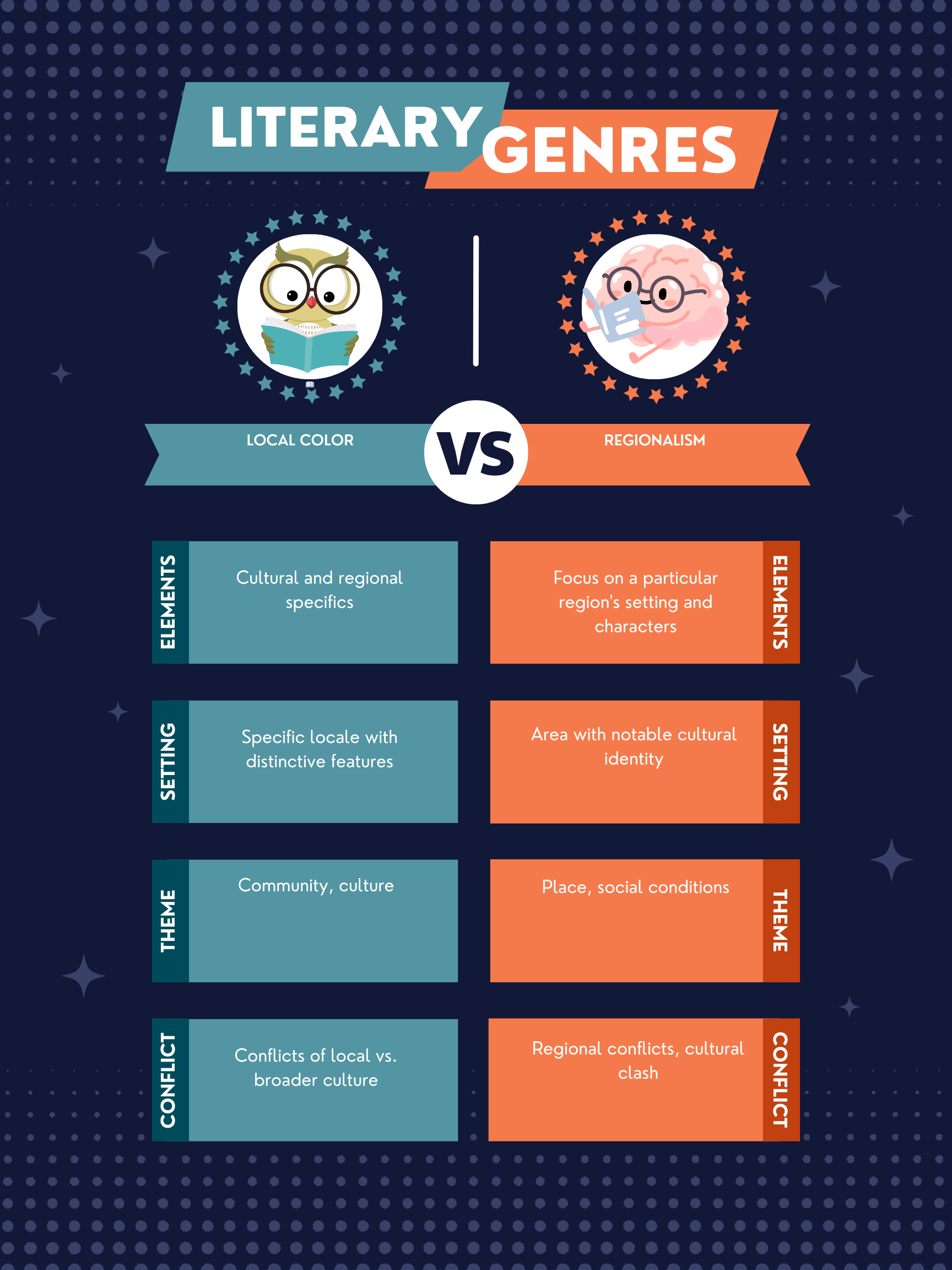Local Color refers to the use of specific details to recreate the language, customs, geography, and habits of a particular area; Regionalism is a focus in literature on the characters, dialect, customs, topography, and other features particular to a specific region.
Both Local Color and Regionalism enrich narratives by deeply rooting them in real or fictional locales, offering readers a vivid sense of place and culture. Let’s explore these concepts further. 🌍✒️
Local Color
Local Color emphasizes specific details such as dialects, settings, and customs to capture the essence of a particular place. This literary device aims to transport readers, allowing them to experience the region’s unique atmosphere and character. Mark Twain’s “The Adventures of Huckleberry Finn” is renowned for its rich use of local color, depicting the dialects and landscapes of the American South.
Regionalism
Regionalism narrows the focus even further, not just detailing the setting but also how it shapes the lives and personalities of characters. It often explores how the geographical and cultural landscape influences the narrative and its characters. Willa Cather’s “My Ántonia” exemplifies Regionalism, exploring the lives of immigrants on the Nebraska prairies and how the land itself becomes a central character in their stories.
Summary
| Literary Device | Definition | Purpose | Usage | Relevant Examples |
|---|---|---|---|---|
| Local Color | Uses details to recreate the language, customs, geography, and habits of a particular area. | To immerse readers in the unique atmosphere and character of a specific place. | Short stories, novels. | “The Adventures of Huckleberry Finn” by Mark Twain. |
| Regionalism | Focuses on the characters, dialect, customs, topography, and other features particular to a specific region. | To explore how a specific region influences the narrative and its characters. | Novels, short stories. | “My Ántonia” by Willa Cather. |
Writing Tips
For Local Color:
- Research Thoroughly: Understand the dialect, customs, and geography of the area you’re depicting.
- Use Descriptive Language: Vividly describe the setting and people to transport readers to the location.
- Balance Detail and Narrative: Ensure that the local color supports, rather than overwhelms, the story.
For Regionalism:
- Deepen Character Development: Show how the region shapes your characters’ beliefs, behaviors, and fates.
- Integrate the Setting: Make the region a dynamic element of the story, influencing the plot and character arcs.
- Highlight Conflict: Explore tensions between characters and their environment or between individuals from different regions.
FAQs
Can a work incorporate both Local Color and Regionalism?
Yes, many works blend both, using detailed regional characteristics to set the scene and explore deeper themes related to the setting’s influence on characters.
How do I choose between Local Color and Regionalism for my story?
Consider your story’s focus. If you aim to create an immersive sense of place with detailed descriptions, Local Color is key. If you want to delve into how a region affects its inhabitants and the narrative, Regionalism is more appropriate.
Exercise
Read the following excerpt: “The winding streets of the small coastal town, with its distinct dialect and seafaring customs, shaped the lives of its residents, influencing their choices and destinies.”
Answer: This passage hints at Regionalism by focusing on how the coastal town’s unique characteristics impact its residents’ lives, beyond just setting the scene.
Other Interesting Literary Device Comparisons
- Symbolism vs Allegory: Symbolism uses symbols to signify ideas and qualities, while allegory uses symbolic figures and actions to convey hidden meanings, often moral or political.
- Foreshadowing vs Foreboding: Foreshadowing hints at future events, while foreboding creates a sense of impending doom without specific details.
- Irony vs Satire: Irony involves a discrepancy between expectations and reality, while satire uses humor, irony, or exaggeration to critique or mock societal flaws.
By understanding and applying Local Color and Regionalism, writers can craft rich, immersive narratives that resonate deeply with readers, offering them a window into unique worlds shaped by their geographical and cultural landscapes. 📚🌐

